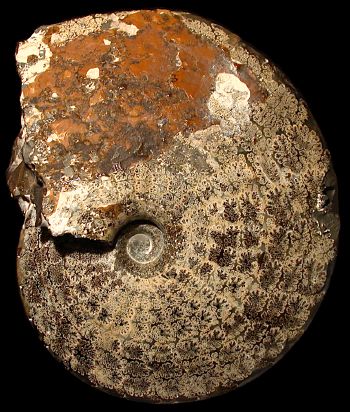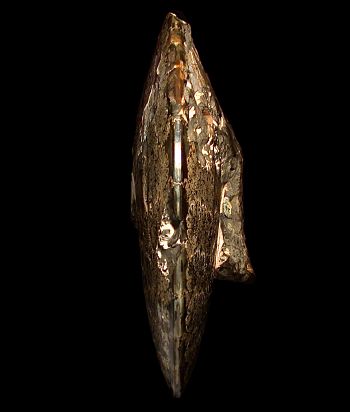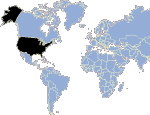




Placenticeras meeki (Böhm 1898) (M) |
||
Placenticeras meeki (Böhm 1898) (M)
Étage
Campanien (-83 à -72 millions d'années) supérieur
Localité
South Dakota - U.S.A.

Dimensions
Diamètre = 25 cm (9.84")
Commentaire
Classification
Genre :
Placenticeras Meek 1876
Albien sup. à Campanien qup.
Forte variabililité. De formes comprimées, involutes, à flancs convergents un peu bombés, ventre plat et étroit, faibles côtes falcoïdes, bullae ombilicales allongées, tubercules latéro-ventraux internes et externes plus denses, à formes similaires dans les tours internes, puis devenant plus évolutes, à section rectangulaire à carrée, tubercules plus forts, le latéro-ventral interne pouvant migrer d’une position mi-latérale jusqu’au bord ventral tandis que l’externe disparaît.
Famille :
Placenticeratidae Hyatt 1900
Albien supérieur à Maastrichtien supérieur.
Taille moyenne à grande. Les tours internes sont généralement involutes, comprimés, le ventre étroit, plat ou creusé d’un sillon. L’ornementation est discrète ou absente. Les tours externes sont plus évolutes, plus ou moins renflés avec une ornementation forte.
Super-famille :
Hoplitoidea Douvillé 1890
Aptien supérieur à Maastrichtien supérieur
Descendants du genre Uhligella (Desmoceratidae) développant une ornementation robuste typiquement constituée de côtes divisées à partir de tubercules ombilicaux. Beaucoup possèdent un ventre plat ou concave bordé de clavi latéro-ventraux. Le dimorphisme n’est pas parfaitement résolu, mais les microconques ont probablement une ouverture simple. Les sutures sont de type Desmoceratoidea, sauf chez les Placenticeratidae et Engonoceratidae, dont les éléments sont multipliés et développent des caractères particuliers.
Sous-ordre :
Ammonitina Hyatt 1889
Ordre :
Ammonoidea Zittel 1884
Classe :
Cephalopoda Cuvier 1797
Embranchement :
Mollusca Linnaeus 1758
Super-embranchement :
Bilateria: Protostomia Hatschek, 1888: Grobben 1908
Sous-règne :
Eumetazoa Butschli 1910
Règne :
Animalia Linnaeus 1758
Super-règne :
Eukaryota Whittaker & Margulis 1978
Documents
2022. Sealey, P., L. & Lucas, S., G.
Late Cretaceous (Campanian-Maastrichtian) ammonites from the Pierre Shale, Raton Basin, Northeastern New Mexico and Southern Colorado
in Bulletin of the New Mexico Museum of Natural History and Science - 91 - New Mexico Museum of Natural History and Science
p 60, fig 45-47 (=Placenticeras meeki BÖHM, 1898) - lien
2006. Landman, N., H., Tsujita, C., J., Cobban, W., A., Larson, N., L., Tanabe, K. & Flemming, R., L.
Jaws of Late Cretaceous Placenticeratid Ammonites: How Preservation Affects the Interpretation of Morphology
in American Museum Novitates - Number 3500 - American Museum of Natural History
p 1, 3, 7, 8, 10, 11, 15, 17-19, 21, 22, 24, 26, 28, 30, 45
2002. Bardhan, S., Gangopadhyay, T., K. & Mandal, U.
How far did India drift during the Late Cretaceous? - Placenticeras kaffrarium Etheridge, 1904 (Ammonoidea) used as a measuring tape
in Sedimentary Geology - 147 (1-2) - Elsevier
p 204, 205 - lien
2002. Monks, N. & Palmer, P.
Ammonites - The Living Past Series
Smithsonian Institution Press, Washington, D.C. & The Natural History Museum, London
p 131
1999. Santucci, V., L., Hays, D., Staebler, J. & Milstein, M.
A Preliminary Assessment of Paleontological Resources at Bighorn Canyon National Recreation Area, Montana and Wyoming
in National Park Service Paleontological Research - Technical Report NPS/NRGRD/GRDTR-99/03 - Santucci, V., L. & McClelland, L. - United States Department of the Interior - National Park Service - Geological Resource Division
p 20, 21
1998. Tsujita, C., J. & Westermann, G., E., G.
Ammonoid habitats and habits in the Western Interior Seaway: a case study from the Upper Cretaceous Bearpaw Formation of southern Alberta, Canada
in Palaeo (Palaeogeography, Palaeoclimatology, Palaeoecology) - 144 - Elsevier Science Ltd.
p 138, 145-147, 151, 153, 155
1997. Kennedy, W., J., Cobban, W., A. & Landman, N., H.
Campanian Ammonites from the Tombigbee Sand Member of the Eutaw Formation, the Mooreville Formation, and the Basal Part of the Demopolis Formation in Mississippi and Alabama
in American Museum Novitates - Nb 3201 - American Museum of Natural History
p 10
1997. Kennedy, W., J., Cobban, W., A. & Landman, N., H.
Two Species of Placenticeras (Ammonitina) from the Upper Cretaceous (Campanian) of the Western Interior of the United States
in American Museum Novitates - Number 3173 - American Museum of Natural History
p 1
1997. Landman, N., H. & Lane, J., A.
Foldlike Irregularities on the Shell Surface of Late Cretaceous Ammonoids
in American Museum Novitates - Number 3197 - American Museum of Natural History
p 11, 13
1997. Larson, N., L., Jorgensen, S., D., Farrar, R., A. & Larson, P., L.
Ammonites and the Other Cephalopods of the Pierre Seaway - An identification guide
Geoscience Press, Inc., Tucson Arizona
p 68
1993. Kennedy, W., J. & Cobban, W., A.
Lower Campanian (Upper Cretaceous) ammonites from the Merchantville formation of New Jersey, Maryland, and Delaware
in Journal of Paleontology - 67(5) - Paleontological Society
fig 7, 8 (=Placenticeras meeki BÖHM, 1898) - lien
1903. Hyatt, A.
Pseudoceratites of the Cretaceous
in Monographs of the United States Geological Survey - Volume XLIV - United States Geological Survey - Department of the Interior
p 221, pl XLV-XLII (=P. whitfieldi n. sp.) - lien
Contenu révisé le 5 janvier 2024 - Fiche générée le 5 janvier 2024 - 1ère publication le 16 avril 2007
Placenticeras meeki est présente de la zone E. jenneyi à la zone à B. cuneatus (Campanien sup.) dans la Mer Intérieure américaine.
C’est un Placenticeras oxycône lisse, aux sutures cloisonnaires spectaculairement découpées, dont la coquille dépassait parfois 1 mètre de diamètre. Le ventre s’arrondit chez les grands individus. Certains specimens portent de petits tubercules ombilicaux et une très faible costulation large et basse.